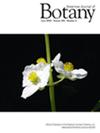Can biocrust moss hide from climate change? Fine-scale habitat sheltering improves summer stress resistance in Syntrichia caninervis
Abstract
Premise
Mosses provide many ecosystem functions and are the most vulnerable of biocrust organisms to climate change due to their sensitive water relations stressed by summer aridity. Given their small size, moss stress resistance may be more dependent on fine-scale habitat than macroclimate, but the sheltering role of habitat (i.e., habitat buffering) has never been compared to macroclimate and may have important implications for predicting critical biocrust moss refugia in changing climates.
Methods
We located three populations of a keystone biocrust moss, Syntrichia caninervis, spanning 1200 m of altitude, which comprised three macroclimate (elevation) zones of characterized plant communities in the Mojave Desert. We stratified 92 microsites along three aridity gradients: elevation zone, topography (aspect), and microhabitat (shrub proximity). We estimated summer photosynthetic stress (Fv/Fm) and aridity exposure (macroclimate, irradiance, and shade).
Results
Microsite aridity exposure varied greatly, revealing exposed and buffered microhabitats at all three elevation zones. Moss stress did not differ by elevation zone despite the extensive macroclimate gradient, failing to support the high-elevation refugia hypothesis. Instead, stress was lowest on northerly-facing slopes and in microhabitats with greater shrub shading, while the importance of (and interactions between) topography, irradiance, and shade varied by elevation zone.
Conclusions
Fine-scale habitat structure appears physiologically more protective than high-elevation macroclimate and may protect some biocrust mosses from the brunt of climate change in widespread microrefugia throughout their current ranges. Our findings support a scale-focused vulnerability paradigm: microrefugia may be more important than macrorefugia for bolstering biocrust moss resistance to summer climate stress.


 求助内容:
求助内容: 应助结果提醒方式:
应助结果提醒方式:


